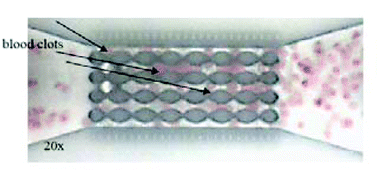Dynamics of capillary flow of blood into a microfluidic channel
Abstract
In this paper, a novel mathematical approach is devised to analyze the flow of blood from a droplet into a microcapillary channel. Special attention is devoted to estimate the effects of variable hydraulic resistance over different flow regimes, influence of suspended RBC particulates on the non-Newtonian flow characteristics and implications of a dynamically-evolving contact angle. Flow characteristics depicting advancement of the fluid within the microfluidic channel turn out to be typically non-linear, as per relative instantaneous strengths of the capillary forces and viscous resistances. It is found that the greater the ‘pseudoplasticity’ of the blood, the weaker the retarding shear forces. The driving forces, on the other hand, become stronger with time, on account of a reduction of contact angle with a decrease of blood flow velocity, although this strengthening is less prominent for blood samples with greater ‘pseudoplasticity’. It is revealed that RBCs suspended in blood samples have a strong influence on the effective blood viscosity, and consequently, may drive the fluid significantly faster into the microchannel, especially when the characteristic length scales of the suspensions approach the hydraulic radius of the channel.


 Please wait while we load your content...
Please wait while we load your content...